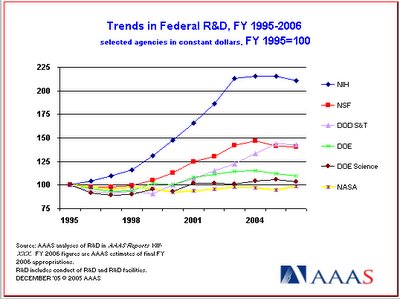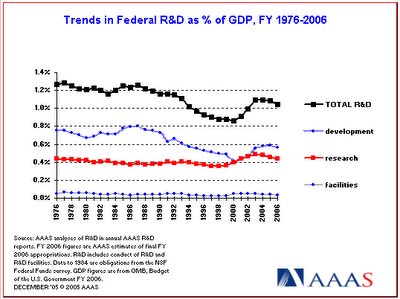The Final FY 2006 Appropriations Bills for Federal R&D
From a statement released by the AAAS:
And now time for some data. Funding of several federal R&D agencies over the past 10 years (adjusted for inflation):

R&D (deffence and basic research) funding as a percent of GDP:
 The future of funding for federal R&D programs? Here's the last paragraph of the report:
The future of funding for federal R&D programs? Here's the last paragraph of the report:
On December 30, nearly three months into the fiscal year, President Bush signed the last two FY 2006 appropriations bills into law, bringing the FY 2006 appropriations process to a close. AAAS estimates that the federal R&D portfolio totals $134.8 billion in 2006, a $2.2 billion or 1.7 percent increase. But 97 percent of the increase goes to just two areas: defense weapons development and human space exploration technologies. Funding for all other federal R&D programs collectively will barely increase, and will fall nearly 2 percent after adjusting for inflation.
...
Many flagship federal science agencies have disappointing budgets in 2006: the National Institutes of Health (NIH) budget falls for the first time in 36 years; the National Science Foundation (NSF) wins a small increase but has less in real terms for its research portfolio than in any of the last three years; the Department of Energy (DOE) Office of Science budget declines, and despite big increases in development funding the Department of Defense (DOD)’s basic research funding declines.
...
...the bill also contained a 1 percent across-the-board cut for all discretionary programs, even those whose budgets had already been signed into law earlier. Even before the across-the-board cut appeared, the President and Congress had agreed to cut overall domestic discretionary spending by nearly 1 percent, but now it appears that domestic spending will fall almost 2 percent in 2006.
And now time for some data. Funding of several federal R&D agencies over the past 10 years (adjusted for inflation):

R&D (deffence and basic research) funding as a percent of GDP:
 The future of funding for federal R&D programs? Here's the last paragraph of the report:
The future of funding for federal R&D programs? Here's the last paragraph of the report:Although many lawmakers of both parties have called on the U.S. to dramatically boost its investments in basic research in order to ensure U.S. innovative capacity and therefore future economic competitiveness, these proposals have run into a brick wall of tight budgets. Looking back on 2005, there finally appeared to be bipartisan and widespread recognition that the U.S. leadership in science and technology, innovation, and technology-based competitiveness were under threat from emerging economic competitors, especially India and China, but instead of boosting R&D investments policymakers cut them to meet restrictive budget targets. And things could get worse before they get better: the Bush Administration’s FY 2007 budget proposal, due in February, is primed to continue the same combination of tax cuts, declining discretionary spending, and modest entitlements reforms that have characterized past budgets, resulting in what is likely to be another year on the downward slope for most parts of the federal R&D portfolio.


<< Home